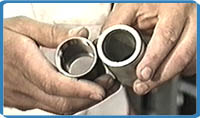|

|
|
Frames & Materials
Page: 2 of 4
|
|
Materials for Frames (continued)
|
|
Steel
"Steel has been around a long time. It's probably
the most researched, well known, and the most used material in just about
every industry. It's the most tunable, in the sense that if you want to
tune a frame the way someone tunes a piano, you have a really great selection
of tubes that you can select from." Steel is also generally the most
affordable of the materials listed here.
|


|
Paolo talks about working with steel.
|
|
|

|
A section of thin-walled steel tubing next to a thicker-walled aluminum
tube. Even with the thick wall, the aluminum tube is lighter.
|
|
Aluminum
"Aluminum is an interesting material. You can't really
let it flex, because the more it gets to bend the quicker it reaches the
end of its life. That's why you see a lot of aluminum frames today that
have very large diameter tubing. That's to limit the flexing that happens
as you ride the bike."
|

|
|
|
Paolo discusses the qualities of aluminum.
|
|
|
|
Titanium
"It seems that titanium is the material of choice.
It has a great strength-to-weight ratio. You don't need to paint it and
it looks good over a long period of time. It has forgiving qualities when
it collides with other things. It tends to return to its original shape,"
explained Paolo. The cost however is another matter. Titanium tubing can
cost up to 15 times more than steel.
|

|
|
|
Paolo talks about titanium.
|
|
|

|
Paolo has mastered the difficult technique of welding titanium. Proper welds
and the strength of the material will ensure that the final frame is strong
enough to handle a variety of stresses.
|
|
|

|
Paolo examines a recently welded headtube on a titanium frame. Paolo welds
steel, aluminum, and titanium. To create a carbon-fiber bike the torch is
put away and layers of carbon "fabric" are placed over a template
or in a mold.
|
|
Carbon-Fiber
"It's the boat builder's material, as a friend of
mine calls it. It's really interesting because unlike the other materials,
where you have to draw it into a tube or forge it into a section, with carbon
you can literally change the direction of the fabric in a certain area which
will affect the way a load comes through that area. So in a sense when you
build a carbon frame you feel like a tailor."
|

|
|
|
Paolo talks about using carbon-fiber for frames.
|
|
|
|
Yield and Ultimate Strength
One way to compare materials is to look at their yield
and ultimate strength. Paolo used an example of a plastic comb. "When
you bend a plastic comb, you let go and it will return to its original form.
Then there is a point where you bend a plastic comb and it keeps the shape
you've bent it into. Then there's a point where you actually break it."
|

In this case the frame held together but the wheel failed. Although (as
mentioned in "The Wheel" section) bicycle wheels are one of the
strongest man-made structures, extreme forces can overcome them. Click on
the image to view a QuickTime movie (880K) of what caused this.
IMAGE & VIDEO PROVIDED BY LOGAN KELSEY
|
|
These three modes for comparison of materials are quite important because
they affect how a frame is designed. The most visible example of this is
the large tubing one sees on aluminum bicycles. Paolo explained that the
yield and ultimate strength of aluminum are quite close. This means that
if the bicycle is subjected to strong forces, the point at which it will
bend is very close to the point at which it would fail completely. The large
size tubing is stronger than its smaller counterparts and keeps the bike
from flexing or bending--since that might mean the material would fail.
|
|
|
Frames & Materials
Page: 2 of 4
Select "Forward" below to continue
|

©
Exploratorium
|

